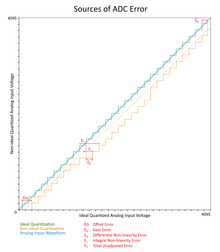Analog and Digital Conversion/Sources of Error
Introduction[edit | edit source]

Recall that in an ideal ADC, a continuously variable analog input waveform will be quantized (converted to a discrete digital value). Imagine a linear analog input signal starting at 0V and ending at its full-scale range value (e.g. 5V, 10V, 15V, or some other maximum value). An ideal ADC will read those analog values in and convert the analog voltages to a perfect stair step digital representation. A non-ideal ADC will read those analog values in and be influenced by both noise and errors in the system. Four main error sources exist:
- Offset Error - X-intercept Shifting
- Gain Error - Slope Shifting
- Differential Non-linearity Error (DNL) - Maximum single step error
- Integral Non-linearity Error (INL) - Maximum accumulative step error
Offset Error[edit | edit source]
Offset error can be simply understood as an error that shifts the x-intercept of the end-point correlation line. The end-point correlation line is a line drawn from bit 1 to the final bit in the non-ideal transfer curve (i.e. the quantized stair step). For example, if the ideal quantized value corresponding to 1V is 819 bits and the offset error is +2 bits, then the non-ideal quantized value will be 821 bits.
<Additional information requested here>
Gain Error[edit | edit source]
Gain error can be simply understood as an error that shifts the slope of the end-point correlation line. Because gain error compounds over the range of the analog input, gain error can be negligible in one part of the full scale input range while being significant in another.
<Additional information requested here>
Differential Non-linearity Error[edit | edit source]
Differential non-linearity error can be simply understood as the maximum deviation that appears between the ideal quantized value and the actual one. For example, the non-ideal transfer curve may deviate from the ideal transfer curve by 1 bit in some places, however if it deviates from the ideal transfer curve by a maximum of 2 bits in one place, then the differential (difference, or delta) non-linearity error is considered to be 2 bits.
<Additional information requested here>
Integral Non-linearity Error[edit | edit source]
Integral non-linearity error can be simply understood as the maximum deviation that occurs between the non-ideal transfer curve and its end-point correlation line. For example, as various errors stack up along the non-ideal transfer curve, eventually there will be a summing effect of errors which is considered the integral (summing) non-linearity error.
<Additional information requested here>